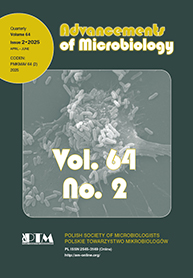Zastosowanie testu Amesa do oceny aktywności mutagennej zanieczyszczeń gleby
1. Wstęp. 2. Ekstrakcja zanieczyszczeń genotoksycznych. 2.1. Techniki ekstrakcji. 2.2. Rozpuszczalniki organiczne. 2.3. Woda jako rozpuszczalnik. 2.4. Warunki ekstrakcji. 3. Szczepy Salmonella Typhimurium stosowane do oceny aktywności mutagennej zanieczyszczeń gleby. 4. Stężenie frakcji mikrosomalnej S-9 i metodyka jej aktywacji. 5. Preinkubacja. 6. Podsumowanie
Abstract: The Ames test is universally used for examining the mutagenic activity of contaminated soil samples. Soil pollution is mostly extracted with the use of an ultrasonic bath or Soxhlet’s apparatus. Dichloromethane and methanol are commonly applied solvents for the extraction of soil pollutants. Methanol was the most effective solvent. A mixture or the sequence of solvents was also applied for the extraction. Less effective was the extraction of soil pollutants in the form of water leakage. There is no sufficient literature data for determining optimal conditions of the extraction. Variants of the biotest technique applied by different authors demonstrated the significant diversity. The organisms tested the most often were strains of Salmonella Typhimurium TA 98 and TA 100. Its different sensitivity on extracts genotoxicity suggests the predominance of soil pollutants causing the mutation of the reading phase, which could be detected only by Salmonella Typhimurium TA 98, whereas mutations of the substitution of base pairs, are detected with the use of Salmonella Typhimurium TA 100. For activating promutagens a microsomal fraction S-9, obtained from the liver of rat, has most often been applied in different concentrations, which is activated by Aroclor 1254. Some authors applied a preincubation when performing Ames test for the genotoxicity evaluation of soil pollutants. Papers concerning the influence of the preincubation on the mutagenic effect in Ames test are rarely found. Collected literature data show the significant usefulness of the Ames test for the evaluation of mutagenic activity of soil pollutants. The comparison of the results obtained by different authors prevents the diversification of extraction techniques, solvents application and some aspects of biotest: test strains, the concentration and the preparation of the microsomal faction S-9, the possibility of applying the preincubation. Unification of the extraction technique and the biotest, taking into consideration soil diversity and pollutants types would facilitate the comparison of the results.
1. Introduction. 2. The extraction of genotoxic pollutants. 2.1. Methods of the extraction. 2.2. Organic solvents. 2.3. The water as the solvent. 2.4. Extraction’s conditions. 3. Salmonella Typhimurium strains used to evaluation of the mutagenic activity of soil’s pollutants. 4. S-9 microsomal fraction’s concentration and its activation’s methods. 5. Preincubation. 6. Conclusion

